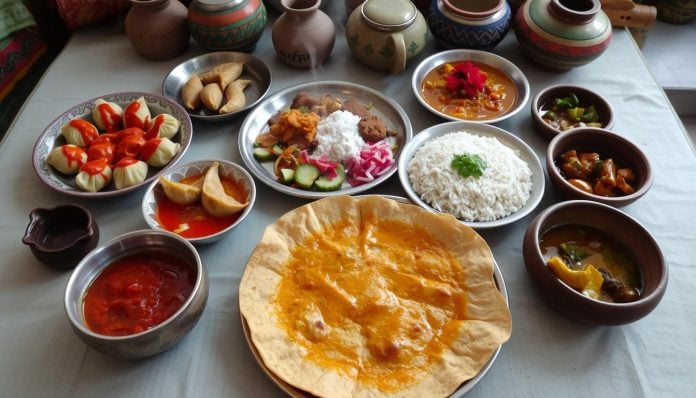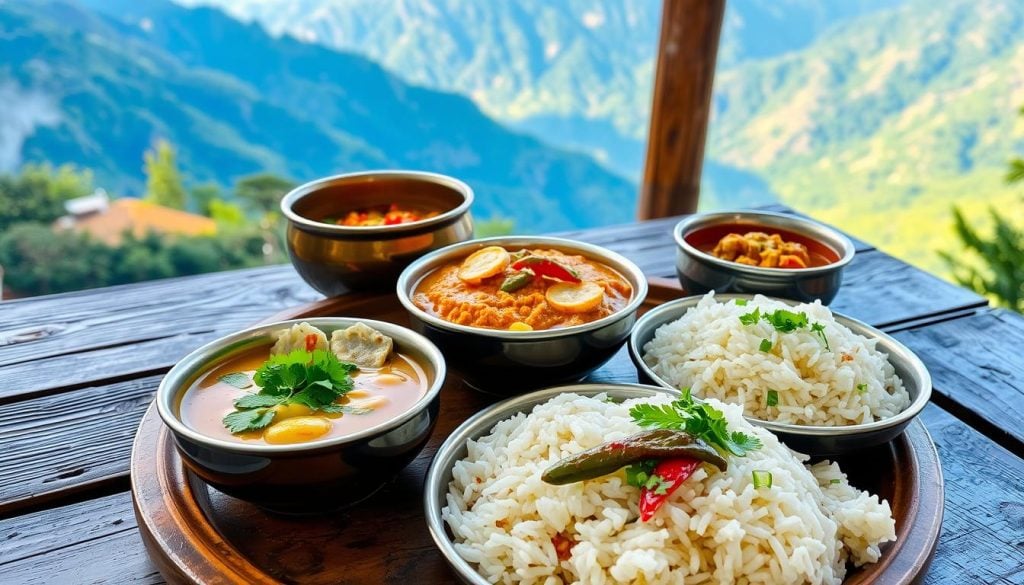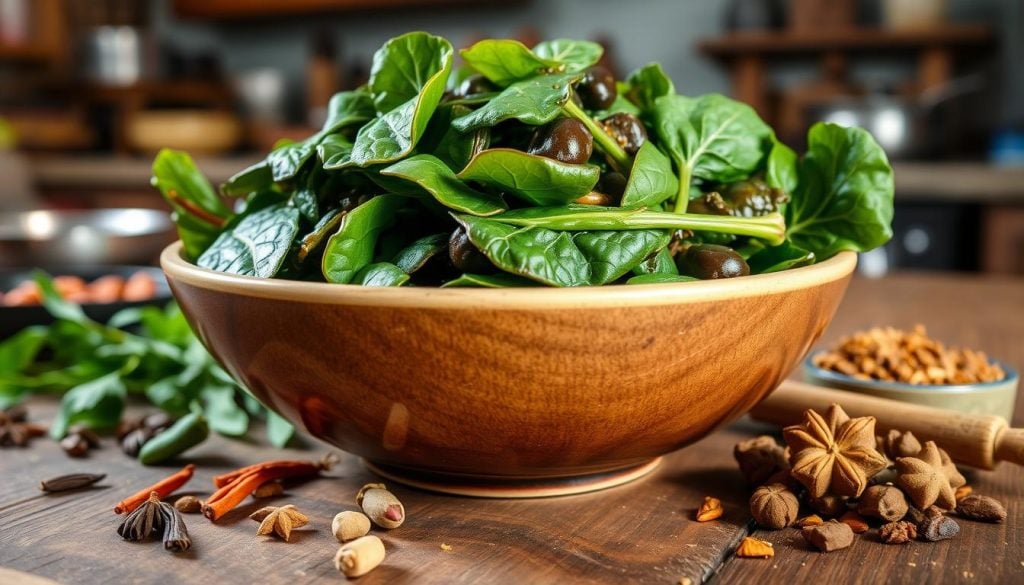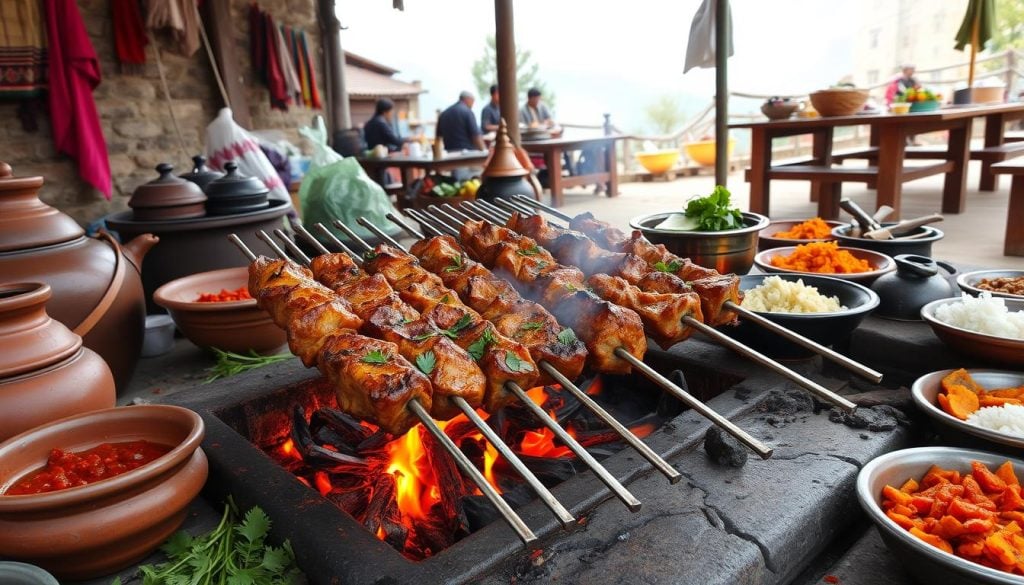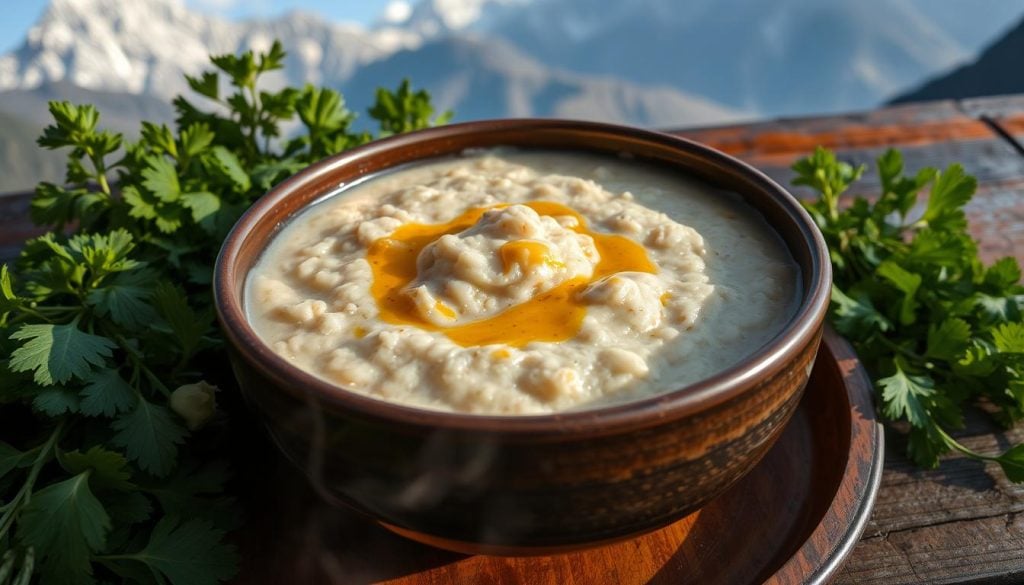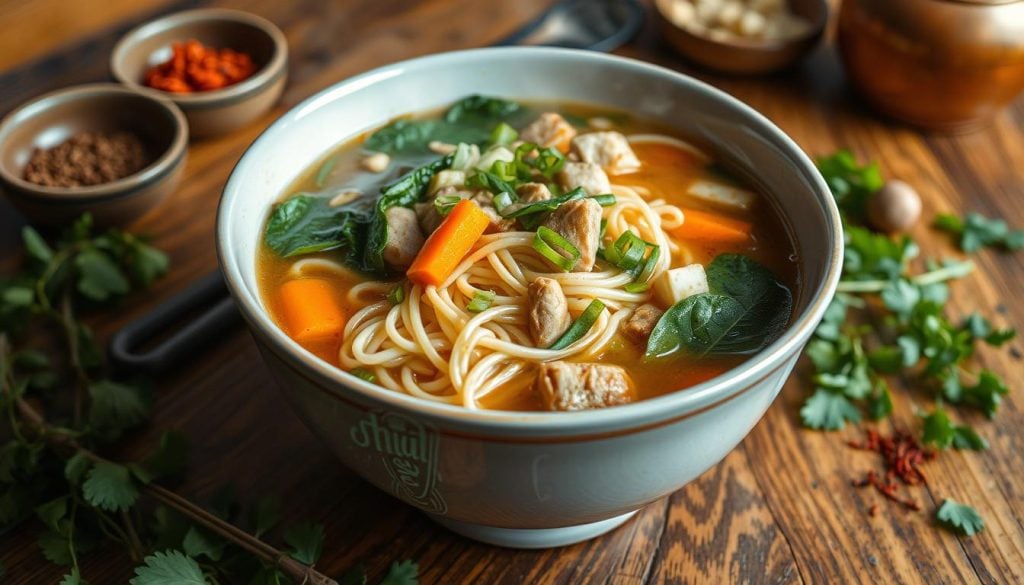Ever wondered what flavors truly define a culture? Traditional Nepali dishes are more than just food; they celebrate heritage. From the Himalayas to busy streets, Nepali food is a mix of tastes and smells. It shows the country’s diverse people and places.
This guide takes you on a journey to try Nepali dishes. You’ll learn about the rich flavors and the stories behind each dish. As you explore, you’ll discover the charm of Nepali recipes. Each dish invites you to taste Nepal’s essence.
Introduction to Nepali Cuisine
Nepali cuisine is a mix of flavors and ingredients that show the country’s rich culture and geography. You’ll find staples like rice, lentils, and veggies, mixed with spices like cumin, coriander, and turmeric. This mix makes some of the best Nepali dishes, each unique to its region.
Knowing the cultural background of these foods makes dining more enjoyable. Each dish tells a story of Nepal’s history and traditions. Whether it’s Dal Bhat or Momos, the taste takes you straight to Nepal.
Exploring regional specialties lets you discover the best dishes and their stories. This journey through Nepali cuisine is a taste adventure. It invites you to experience Nepal’s culture through its food.
What are some traditional Nepali dishes I should try?
Exploring traditional Nepali dishes lets you taste a variety of flavors and textures. These dishes show the country’s rich culinary heritage. They use essential ingredients, making each meal unique.
Overview of Essential Ingredients
Traditional Nepali cooking starts with staples like rice, lentils, and fresh veggies. These ingredients create a perfect balance in famous Nepali dishes. Key ingredients in daily meals are:
- Rice: Often served as bhat, it’s the base for many dishes.
- Lentils: Dal is common, adding protein and flavor.
- Tarkari: Vegetable curries add variety and freshness to meals.
Regional Variations in Traditional Dishes
Different regions in Nepal add to the variety of dishes by using unique spices and cooking methods. For example, the Newar community from the Kathmandu Valley has its own special dishes. Some notable regional specialties include:
| Region | Dish | Description |
|---|---|---|
| Hilly Regions | Dhindo | A wholesome alternative to rice, made from buckwheat or millet flour. |
| Southern Areas | Tanthuk | A noodle dish that combines wheat noodles with a variety of vegetables and meats. |
| Kathmandu Valley | Yomari | A sweet steamed dumpling filled with a mixture of coconut and jaggery. |
Dal Bhat: The Heart of Nepali Meals
Dal Bhat is at the core of Nepali meals. It’s loved for its mix of tastes and health benefits. It’s a key dish in many homes, showing its importance in Nepali culture.
Components of Dal Bhat
A typical Dal Bhat includes:
- Steamed Rice (Bhat): The main carb source.
- Lentil Soup (Dal): Rich in protein and fiber.
- Curried Vegetables: Seasonal veggies, spiced for taste.
- Pickle: Adds a tangy flavor.
This mix not only fills you up but also gives you carbs, proteins, and nutrients.
Popularity and Cultural Significance
Dal Bhat is more than a meal; it’s a symbol of Nepali culture. Families enjoy it together, sharing stories and laughter. This strengthens their bond and sense of community.
The cultural value of Dal Bhat is immense. It represents warmth and nourishment, showing Nepali hospitality. Its making often involves family recipes, connecting people to their culinary past.
| Component | Nutritional Benefits |
|---|---|
| Steamed Rice (Bhat) | High in carbohydrates, provides energy. |
| Lentil Soup (Dal) | Rich in protein, fiber, and essential vitamins. |
| Curried Vegetables | Provides vitamins, minerals, and dietary fiber. |
| Pickle | Adds flavor and probiotics for digestion. |
Momos: Delicious Nepalese Dumplings
Momos are a delightful treat that show the essence of popular Nepali foods. These delicious Nepalese dumplings are loved not just in Nepal but around the world. They are often inspired by Tibetan cuisine and filled with a mix of ingredients, pleasing everyone.
The variety of momos is impressive. You can find them filled with minced buffalo or chicken. Vegetarian versions use cabbage, carrots, and cheese. This variety lets you try different flavors and textures, making them a must-try.
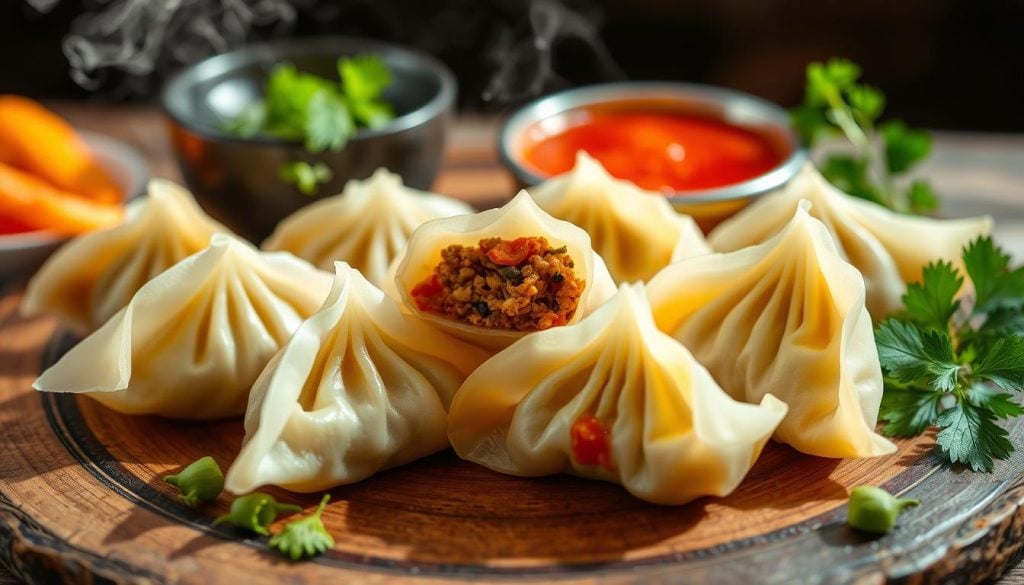
Momos are made as steamed or fried dumplings. They are served with a spicy dipping sauce that boosts their flavor. The mix of soft outer layer and savory filling is irresistible. Momos are also culturally significant in Nepal, making them a beloved dish.
| Momo Type | Common Fillings | Cooking Method |
|---|---|---|
| Meat Momos | Buffalo, Chicken | Steamed or Fried |
| Vegetarian Momos | Cabbage, Carrots, Cheese | Steamed |
| Specialty Momos | Spicy Veg, Paneer | Fried |
Exploring Nepal’s culinary scene? Don’t miss out on these amazing momos. Their unique flavors and textures show the blend of Himalayan culinary traditions. They are a standout among must-try Nepali dishes. Enjoy them as a snack or part of a meal, momos are a must-try.
Gundruk: Fermented Greens with Flair
Gundruk is a key ingredient in Nepali cooking, loved for its unique taste and health perks. It’s made from mustard greens that go through a special fermentation. This process makes them taste better and more nutritious. You can find gundruk in many dishes, like side dishes, soups, or as a pickle called gundruk ko achar.
This ingredient adds a tangy flavor to meals. It’s also full of probiotics, which are good for your gut.
Health Benefits and Preparation Methods
Eating gundruk can do a lot of good for you. The fermentation helps grow healthy bacteria in your gut. It’s also rich in vitamins and minerals, making it great for your health. Here’s how to make gundruk:
- Harvest fresh mustard greens or other leafy vegetables.
- Wash and chop the greens into small pieces.
- Pack the greens tightly into a jar or container, pressing down to eliminate air pockets.
- Allow the greens to ferment at room temperature for several days, monitoring for taste and texture.
After it’s fermented, gundruk can be added to your meals for a healthy and tasty touch. Discover the unique taste and health benefits of fermented greens in Nepali cuisine.
Thakali Khana: A Hearty Platter
Thakali Khana is a key part of the Thakali community’s food traditions. It’s known for its colorful and varied dishes that make a complete meal. A typical Thakali Khana includes Dal Bhat, along with many other tasty items like curries, pickles, and gundruk. It’s not just tasty; it’s also very nutritious, loved by both locals and tourists.
The look of Thakali Khana is stunning. Each dish is a colorful feast for the eyes. The way it’s presented shows the Thakali region’s rich cooking traditions. It uses fresh, local ingredients to make the meal even better. Trying Thakali Khana is like taking a flavorful trip through Nepali culture.
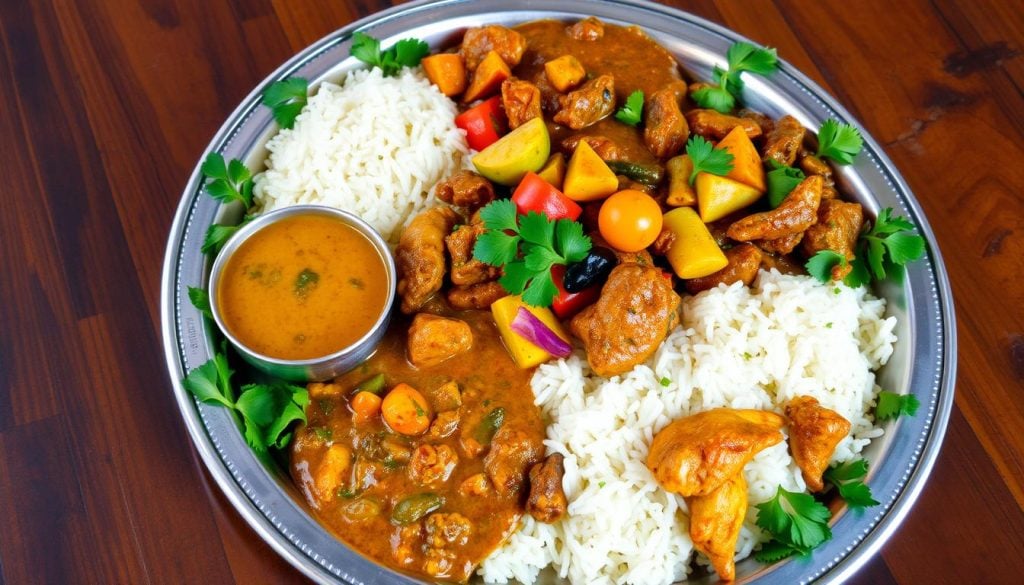
Sharing Thakali Khana with family or enjoying it at a restaurant is special. It reminds us of the importance of sharing meals in Nepali culture. Each dish works well with the others, thanks to the careful choice of spices and cooking methods. It’s a must-try for anyone wanting to taste the real flavors of a Nepali feast.
| Component | Description | Flavor Profile |
|---|---|---|
| Dal | Cooked lentils, often spiced | Earthy and savory |
| Bhat | Steamed rice, a staple | Neutral, pairs well with curries |
| Curry | Variety of meat or vegetable dishes | Spicy and aromatic |
| Pickles | Fruity or spicy condiments | Tangy and bold |
| Gundruk | Fermented leafy greens | Umami and slightly sour |
Choila: Grilled Meat Tradition
Choila is a favorite among Nepali foods, known for its grilled meat. It’s made with marinated buffalo or chicken, mixed with spices. Then, it’s grilled to perfection, giving it a smoky taste. The dish is often red, making it look as good as it tastes.
Serving Styles and Differences from Other Dishes
Served hot, choila goes well with rice flakes or is part of a Newari platter. It’s a highlight of Newar cuisine. Unlike other grilled meats, choila has a spicy marinade and comes with various sides. Its unique preparation and cultural importance make it special in Newari festivals and daily life.
| Characteristic | Choila | Other Grilled Meats |
|---|---|---|
| Meat Used | Bull, Chicken (varies by region) | Varies widely (beef, pork, lamb, chicken) |
| Marinade | Spicy and tangy with special spices | Generally simpler marinades or seasoning |
| Serving Style | With rice flakes or Newari platter | With sides like vegetables or sauces |
| Cultural Significance | Prominent in festivals and celebrations | More common in daily meals without specific significance |
Try choila at your next gathering or local festival. It’s a great way to taste the flavor and culture of this beloved dish.
Dhindo: A Unique Alternative to Rice
Dhindo is a beloved dish in Nepal, made from millet flour or buckwheat. It’s not just a rice substitute but a unique part of Nepali cuisine. The process of making Dhindo involves stirring flour into boiling water until it becomes a gooey porridge.
When you eat Dhindo, it’s often with savory dishes, like those in a Dal Bhat meal. This mix shows Dhindo’s versatility and fits well with Nepal’s rich food culture. Though Dhindo may not be as famous worldwide as rice, it’s valued for its history and health benefits, especially in indigenous communities. Choosing millet and buckwheat supports a more eco-friendly local food scene.
Here are key points about Dhindo:
- Flavor Profile: It’s earthy and filling, standing up to other dishes.
- Nutritional Value: It’s packed with proteins and fibers, making it a better choice than polished rice.
- Historical Significance: Dhindo represents resilience and resourcefulness in Nepali culture.
Trying the best Nepali dishes means you should include Dhindo. This hearty dish offers a unique taste, showing the heart of Nepali food traditions.
Thukpa: A Comforting Noodle Soup
Thukpa is a delightful noodle soup that blends Tibetan flavors in Nepal. It’s a favorite in the cold months, bringing warmth and nourishment to all who try it.
This traditional soup uses homemade noodles, colorful veggies, and sometimes meat. All are cooked in a rich broth. It’s a hearty meal that shows the true taste of Nepal.
Thukpa is often enjoyed together, served in local teahouses and eateries. It brings people together, showing the importance of community in Nepali culture.
Conclusion
Your journey into traditional Nepali dishes shows a rich culinary world. It’s deeply rooted in Nepal’s history and culture. From Dal Bhat to momos and Thukpa, each dish tells a story of the Nepalese people’s heart and soul.
Trying these dishes is more than just eating. It’s a way to see the traditions and stories of Nepal. These meals not only fill your belly but also open a window into the country’s fascinating culture.
Exploring Nepali cuisine lets you enjoy unique flavors and cooking methods. Every meal you try is a celebration of local pride and heritage. Your culinary adventure will deepen your understanding of Nepal’s vibrant culture and its warm people.
In short, your taste of Nepal is an unforgettable experience. It mixes delicious flavors with stories of resilience and hospitality. Make sure to try these traditional dishes. Each meal is an invitation to connect with Nepal’s essence.

































